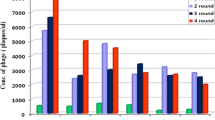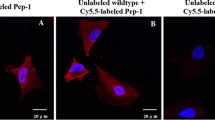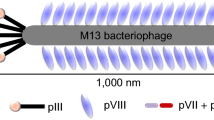Abstract
Aim
To identify linear peptide homing to non-small cell lung cancer (NSCLC) tumor cells using ex vivo phage display method.
Materials and methods
Twenty-six clinical patient samples were used to identify linear homing peptide, which was exposed to NSCLC cell cultures and control cell lines to determine cell binding affinity and cell localization. Also, ex vivo biodistribution was analyzed using tumor-bearing mice.
Results
The panning yielded peptide enrichment with a core motif A/SRXPXXX. Based on this, an amino acid sequence, ARRPKLD, was selected for characterization and named Thx-peptide. The in vitro binding properties of Thx-peptide demonstrated selectivity toward NSCLC. Internalization assays showed that Thx-Alexa and fluorescein conjugates were located in a subset of perinuclearly located lysosomes of tumor cells. Thx-peptide appeared with fluorescein-labeled peptide and peptide-DTPA-chelator complex in adenocarcinoma xenografts in mice.
Conclusion
Thx shows promise for targeted imaging and drug delivery.




Similar content being viewed by others
References
Sun S, Schiller JH, Spinola M, Minna JD (2007) New molecularly targeted therapies for lung cancer. J Clin Invest 117:2740–2750
Jain RK (1996) 1995 Whitaker lecture: delivery of molecules, particles, and cells to solid tumors. Ann Biomed Eng 24:457–473
Heldin CH, Rubin K, Pietras K, Ostman A (2004) High interstitial fluid pressure—an obstacle in cancer therapy. Nat Rev Cancer 4:806–813
Adessi C, Soto C (2002) Converting a peptide into a drug: strategies to improve stability and bioavailability. Curr Med Chem 9:963–978
Smith GP (1985) Filamentous fusion phage: novel expression vectors that display cloned antigens on the virion surface. Science 228:1315–1317
Nilsson F, Tarli L, Viti F, Neri D (2000) The use of phage display for the development of tumour targeting agents. Adv Drug Deliv Rev 43:165–196
Laakkonen P, Akerman ME, Biliran H et al (2004) Antitumor activity of a homing peptide that targets tumor lymphatics and tumor cells. Proc Natl Acad Sci USA 101:9381–9386
Shukla GS, Krag DN (2005) Selection of tumor-targeting agents on freshly excised human breast tumors using a phage display library. Oncol Rep 13:757–764
Zhang B, Zhang Y, Wang J et al (2007) Screening and identification of a targeting peptide to hepatocarcinoma from a phage display peptide library. Mol Med 13:246–254
Newton JR, Kelly KA, Mahmood U, Weissleder R, Deutscher SL (2006) In vivo selection of phage for the optical imaging of PC-3 human prostate carcinoma in mice. Neoplasia 8:772–780
Yang W, Luo D, Wang S et al (2008) TMTP1, a novel tumor-homing peptide specifically targeting metastasis. Clin Cancer Res 14:5494–5502
Lee TY, Lin CT, Kuo SY, Chang DK, Wu HC (2007) Peptide-mediated targeting to tumor blood vessels of lung cancer for drug delivery. Cancer Res 67:10958–10965
Zang L, Shi L, Guo J et al (2009) Screening and identification of a peptide specifically targeted to NCI-H1299 from a phage display peptide library. Cancer Lett 281:64–70
Oyama T, Sykes KF, Samli KN, Minna JD, Johnston SA, Brown KC (2003) Isolation of lung tumor specific peptides from a random peptide library: generation of diagnostic and cell-targeting reagents. Cancer Lett 202:219–230
Willats W (2002) Phage display: practicalities and prospects. Plant Mol Biol 50:837–854
Barbas CF III, Burton DR, Scott JK, Silverman GJ (2001) Phage display: a laboratory manual. Cold Spring Harbor Laboratory, Cold Spring Harbor New York, New York
Boumrah D, Campbell MM, Fenner S, Kinsman RG (1997) Spacer molecules in peptide sequences: incorporation into analogues of atrial natriuretic factor. Tetrahedron 53:6977–6992
Joyce JA, Laakkonen P, Bernasconi M, Bergers G, Ruoslahti E, Hanahan D (2003) Stage-specific vascular markers revealed by phage display in a mouse model of pancreatic islet tumorigenesis. Cancer Cell 4:393–403
Hui X, Han Y, Liang S et al (2008) Specific targeting of the vasculature of gastric cancer by a new tumor-homing peptide CGNSNPKSC. J Control Release 131:86–93
Krag DN, Shukla GS, Shen GP et al (2006) Selection of tumor-binding ligands in cancer patients with phage display libraries. Cancer Res 66:7724–7733
Arap W, Kolonin MG, Trepel M et al (2002) Steps toward mapping the human vasculature by phage display. Nat Med 8:121–127
Maruta F, Akita N, Nakayama J et al (2007) Bacteriophage biopanning in human tumour biopsies to identify cancer-specific targeting ligands. J Drug Target 15:311–319
Kubo N, Akita N, Shimizu A, Kitahara H, Parker AL, Miyagawa S (2008) Identification of oligopeptide binding to colon cancer cells separated from patients using laser capture microdissection. J Drug Target 16:396–404
Lu H, Jin D, Kapila YL (2004) Application of laser capture microdissection to phage display peptide library screening. Oral Surg Oral Med Oral Pathol Oral Radiol Endod 98:692–697
Hong FD, Clayman GL (2000) Isolation of a peptide for targeted drug delivery into human head and neck solid tumors. Cancer Res 60:6551–6556
Langel U (2006) Handbook of Cell-Penetrating Peptides, 2nd edn. Taylor & Francis Group, CRC Press
Futamura M, Nishimori H, Shiratsuchi T, Saji S, Nakamura Y, Tokino T (1999) Molecular cloning, mapping, and characterization of a novel human gene, MTA1-L1, showing homology to a metastasis-associated gene, MTA1. J Hum Genet 44:52–56
Sasaki H, Moriyama S, Nakashima Y et al (2002) Expression of the MTA1 mRNA in advanced lung cancer. Lung Cancer 35:149–154
Holt JT, Thompson ME, Szabo C et al (1996) Growth retardation and tumour inhibition by BRCA1. Nat Genet 12:298–302
Wang Q, Zhang H, Kajino K, Greene MI (1998) BRCA1 binds c-myc and inhibits its transcriptional and transforming activity in cells. Oncogene 17:1939–1948
Conflict of interest
None.
Author information
Authors and Affiliations
Corresponding author
Rights and permissions
About this article
Cite this article
Koivistoinen, A., Ilonen, I.I.K., Punakivi, K. et al. A novel peptide (Thx) homing to non-small cell lung cancer identified by ex vivo phage display. Clin Transl Oncol 15, 492–498 (2013). https://doi.org/10.1007/s12094-012-0959-z
Received:
Accepted:
Published:
Issue Date:
DOI: https://doi.org/10.1007/s12094-012-0959-z




